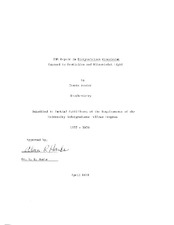| dc.contributor.advisor | Hanks, A. R. | |
| dc.creator | Foster, Travis | |
| dc.date.accessioned | 2022-06-30T15:59:58Z | |
| dc.date.available | 2022-06-30T15:59:58Z | |
| dc.date.issued | 1978 | |
| dc.identifier.uri | https://hdl.handle.net/1969.1/CAPSTONE-FosterT_1978 | |
| dc.description | Program year: 1977-1978 | en |
| dc.description | Digitized from print original stored in HDR | en |
| dc.description.abstract | The cellular slime mold Dictyostelium discoideum is a good organism for studying the excision repair process. The fungicide benomyl is known to have some unusual mutagenic properties; for this reason, we studied its effects on excision repair in the slime mold. By doing a series of survival studies, we first corroborated the existence of genetic repair in the organism. Later, we were able to show a dose dependent decrease in cell viability by benomyl following the inducement of genetic damage with ultraviolet light. Other studies under starvation conditions provided some evidence that the nutrient state of the cell has an influence on genetic repair. A cell division study in buffered saline shows a 17.9% cell increase over a 2.5 hour period. | en |
| dc.format.extent | 18 pages | en |
| dc.format.medium | electronic | en |
| dc.format.mimetype | application/pdf | |
| dc.subject | Dictyostelium discoideum | en |
| dc.subject | excision repair | en |
| dc.subject | fungicide | en |
| dc.subject | benomyl | en |
| dc.subject | ultraviolet light | en |
| dc.subject | genetic damage | en |
| dc.title | DNA Repair in Dictyostelium discoideum Exposed to Pesticides and Ultraviolet Light | en |
| dc.type | Thesis | en |
| thesis.degree.department | Biochemistry | en |
| thesis.degree.grantor | University Undergraduate Fellows | en |
| thesis.degree.level | Undergraduate | en |
| dc.type.material | text | en |


